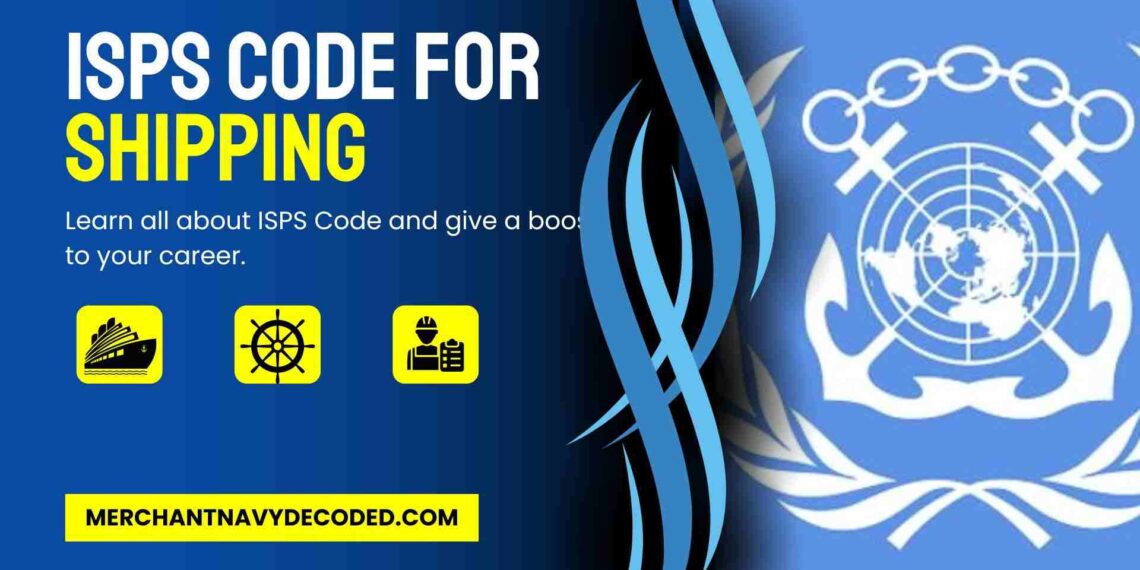ISPS Code: Safeguarding Our Seas
Overview
- Understanding ISPS Code: Learn about the ISPS Code, a global security playbook for ships and ports.
- Why It Matters: Discover why the ISPS Code was created after the 9/11 attacks to keep maritime areas safe.
- Key Goals: Explore the goals of the ISPS Code, including cooperation, clear roles, information sharing, and security planning.
1:- Introduction to ISPS
Safety and security are paramount in the vast expanse of the world’s oceans. With the rise of global trade and travel, ensuring the protection of ships and port facilities has become more crucial than ever. Enter the ISPS Code – the International Ship and Port Facility Security Code. This comprehensive framework acts as a beacon of security, guiding maritime entities through turbulent waters in an ever-evolving landscape of threats. Let’s delve deeper into this vital aspect of maritime safety.
2:- What is ISPS Code?
- The ISPS Code is a set of regulations to enhance the security of ships and port facilities, protecting them from threats like terrorism and piracy.
- It provides a standardized framework for governments, shipping companies, and port authorities to work together in maintaining high-security standards internationally.
3:- Importance of ISPS Code

After 9/11, it became clear that old security measures weren’t enough for new threats. The ISPS Code was created to improve maritime security and protect against risks. This was a significant step, not just routine, in making seas safer. The code wasn’t just for show; it was a real effort to fix security gaps and set up practical steps to prevent and handle threats at sea.
The ISPS Code set out clear guidelines and measures for improving security in the maritime environment. It focused on preventing potential threats and ensuring a swift and effective response if any occurred. The code also emphasized the importance of cooperation and communication among all parties involved in maritime security.
Learn everything about ISPS codes and important questions asked in MEO Exams with our MEO Class 4 Excellence Package.
4:- Working of ISPS Code
4.1:- ISPS Code Part A
- Specific Requirements
- The ISPS Code is a collection of guidelines for maintaining maritime security and Part A of that code forms the basis for all the regulations within ISPS.
- It provides clear goals that must be achieved as per the defined standards by the governments, port authorities and shipping companies to increase the security measures.
- Risk Assessment
- Part A of the ISPS Code helps in detailed risk assessments. This means finding possible security threats and weaknesses in ports, ships, and cargo. The aim is to create specific plans to reduce these risks.
- Designation of Security Levels
- Part A sets up a system to classify security levels based on the threat level. This helps apply the right security measures for each risk level. For higher threats, it means more vigilance. For imminent threats, it means stricter security rules.
- Development of Security Plans
- Part A requires port facilities and ships to create detailed security plans. These plans must include specific measures and procedures to address identified risks and vulnerabilities, ensuring a proactive and coordinated approach to security management.
- Training and Certification
- Part A stresses the need for training and certification of personnel involved in maritime security.
- This includes programs for Port Facility Security Officers (PFSOs), Ship Security Officers (SSOs), and other important staff.
- The goal is to make sure they are skilled in carrying out security measures and responding well to security issues.
4.2:- ISPS Code Part B
- Supplementary Guidance:
- Part B of the ISPS Code provides additional guidance on implementing the guidelines from Part A and suggests more best practices.
- This makes it useful for stakeholders looking to improve their security procedures, as it offers a deeper understanding of the code’s requirements that they can apply to their systems. procedures for their respective systems.
- Security Measures:
- It offers practical guidance on the implementation of various security measures outlined in Part A, such as access control, perimeter security, and surveillance systems.
- It provides recommendations on the selection and deployment of security technologies and procedures to enhance overall security posture.
- Emergency Response
- Part B includes guidance on emergency response procedures and contingency planning to mitigate the impact of security incidents.
- This involves developing protocols for communication, evacuation, and coordination with relevant authorities to ensure a swift and effective response to emergencies.
- Auditing and Compliance
- Part B of the ISPS Code writes procedures for auditing and assessing compliance with the ISPS Code requirements.
- It guides conducting internal audits, external assessments, and port state control inspections to verify adherence to security standards and identify areas for improvement.
- Continuous Improvement
- ISPS Part B stresses the need for ongoing improvement in maritime security. It advises stakeholders to update their security plans regularly based on new threats, technology, and lessons from incidents.
- Part A’s rules and Part B’s advice help maritime organizations improve security, reduce risks, and keep global shipping networks safe.
5:- ISPS Code Security Level
5.1:- Security Level 1 – Normal Operations:
This is the default level at which a ship or port facility operates under regular conditions. At Security Level 1, the basic protective security measures are in place and maintained at all times. This includes continuous monitoring and routine security checks to ensure the safety and security of the vessel and port facility.
5.2:- Security Level 2 – Heightened Risk:
When there is an increased risk of a security threat, Security Level 2 is implemented. This level requires additional protective security measures to address the heightened threat. Enhanced monitoring, stricter access controls, and increased frequency of security patrols are put in place to safeguard against potential security incidents.
5.3:- Security Level 3 – Exceptional Threat:
Security Level 3 is activated when a security incident is imminent or has already occurred. This level enforces the highest level of security measures for a limited time to manage the exceptional threat. Measures include maximum security enforcement, restricted access to critical areas, and heightened alertness among security personnel to ensure the safety of the ship and port facility.
6:- Objectives of ISPS Code

- Cooperation among Countries
- Governments, shipping companies, and ports share information and resources for better security under the ISPS Code.
- ISPS Code promotes global teamwork to set and follow the same security rules for smoother maritime safety worldwide.
- By coordinating efforts globally, the ISPS Code helps make security measures more effective across different regions and countries.
- Defines Roles and Responsibilities
- ISPS Code assigns specific duties to PFSOs, SSOs, and CSOs, ensuring everyone knows what to do, promoting responsibility and effective security measures.
- ISPS Code emphasizes training for security personnel, ensuring they have the know-how to handle security challenges with innovation and diligence in the future.
- Helps in Information Exchange
- ISPS Code ensures security info gets shared promptly among key players like governments, ports, and shipping firms, enabling swift responses to threats and early fixes for better security.
- ISPS Code supports secure communication methods like networks and databases for sharing threat assessments and updates between stakeholders, enhancing maritime security.
- Security Plans
- ISPS Code demands ships and ports create specific security plans based on individual risks, ensuring focused risk management and preparedness.
- Security plans cover everything from access control to handling emergencies like medical crises, piracy, and terrorism, equipping ships and ports with necessary tactics and tools.
- ISPS Code’s security plans are flexible, allowing for adjustments to address evolving security threats and challenges effectively.
7:- ISPS Code Requirements

The ISPS Code, adopted by the International Maritime Organization(IMO), outlines requirements for enhancing maritime security. Key provisions include:
- Ship Security Plans: Ships and port facilities must develop and implement security plans tailored to their specific operations, addressing measures to prevent security incidents.
- Security Measures: The ISPS Code mandates various security measures such as access control, security patrols, surveillance systems, and procedures for handling cargo and personnel to deter security threats.
- Personnel Training: Crew members and port facility personnel undergo security training to recognize and respond to security threats effectively, including procedures for handling suspicious activities or items.
- Security Drills and Exercises: Regular security drills and exercises are conducted to test the effectiveness of security measures, improve response capabilities, and ensure readiness for security incidents.
- Security Assessments: Risk assessments are conducted to identify vulnerabilities and potential security threats, allowing for the implementation of appropriate security measures to mitigate risks.
- Security Communication: Effective communication systems are established to facilitate the exchange of security-related information among ships, port facilities, and relevant authorities to enhance maritime security coordination.
8:- Officers in ISPS Code
8.1:- Port Facility Security Officers (PFSOs)
- Guardians of port facilities, tasked with implementing and overseeing security measures to safeguard against potential threats.
8.2:- Ship Security Officers (SSOs)
- Protectors of vessels, responsible for implementing security protocols and ensuring the safety of crew and cargo during voyage. Company Security Officers (CSOs):
- Oversees of security initiatives within shipping companies, charged with formulating and executing comprehensive security plans.
8.3:- Company Security Officers (CSO)
- The Company Security Officer (CSO) is responsible for implementing and maintaining the ship security plan, ensuring compliance with the International Ship and Port Facility Security (ISPS) Code.
- The CSO oversees security assessments, training, drills, and communicates security-related information to crew members to mitigate security risks and threats effectively.
9:- Conclusion
In an ever-changing world fraught with security challenges, the ISPS Code stands as a beacon of resilience and collaboration, guiding maritime entities toward safer shores. By embracing its principles and fostering a culture of vigilance, we can navigate the seas with confidence, ensuring the continued safety and security of our global maritime network.
Disclaimer :- The opinions expressed in this article belong solely to the author and may not necessarily reflect those of Merchant Navy Decoded. We cannot guarantee the accuracy of the information provided and disclaim any responsibility for it. Data and visuals used are sourced from publicly available information and may not be authenticated by any regulatory body. Reviews and comments appearing on our blogs represent the opinions of individuals and do not necessarily reflect the views of Merchant Navy Decoded. We are not responsible for any loss or damage resulting from reliance on these reviews or comments.
Reproduction, copying, sharing, or use of the article or images in any form is strictly prohibited without prior permission from both the author and Merchant Navy Decoded.





